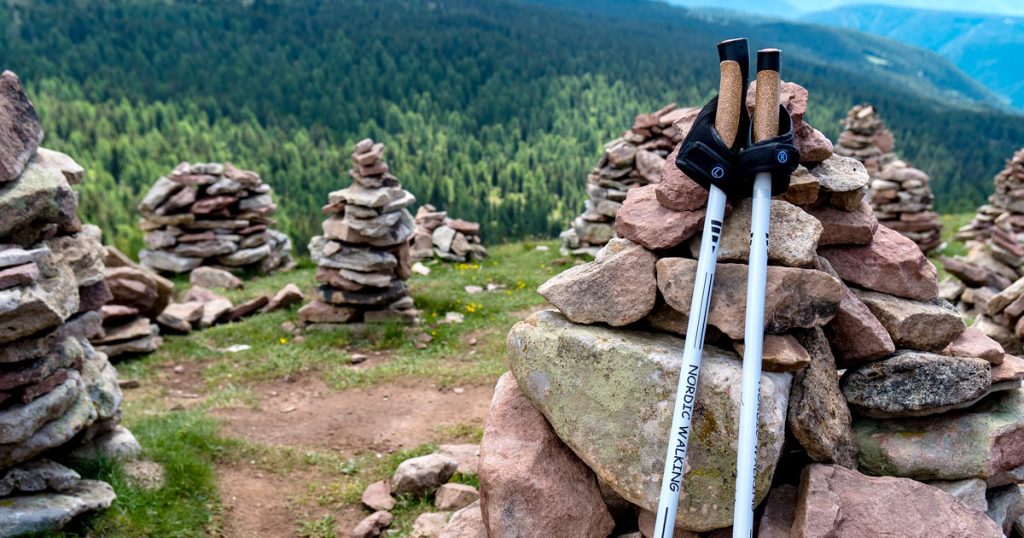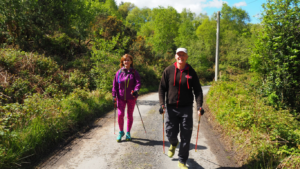Which poles to choose for your travels?
When it comes to walking poles, the variety can be overwhelming: Sticks and Poles, Activators, Exerstriders, Nordic, Urban Poling, Leki, Exel, Gabel… The terminology alone can generate confusion. But what’s it all about?
In this article, we aim to clarify the different types of walking poles to help you make an informed choice. Here are some common questions we’ll address:
- What are the poles designed for?
- Who designed them and why?
- Why are they shaped differently?
- Why do some have straps and others don’t?
- How are they supposed to be used?
- How are they actually used?
- What methods of use are applied to various pole types?
- What assessment methods are used to determine which pole type is best for an individual?
Our Thoughts
As retired Nordic and fitness walking instructors we don’t claim to be the ultimate authority on pole types, but with years of experience working with different clients and using poles ourselves, we’ve learned a lot. Commercial interests, marketing, governing bodies, research articles, and user experiences all influence which poles are recommended for different people. We believe each person is unique and that no single pole type fits all. Assessment is crucial when deciding which poles will be most beneficial. Listening to the client and understanding their goals helps provide the best solution.
Hopefully, our insights will help you navigate the minefield of pole options.
Nordic Walking Poles
Nordic walking poles were first produced in 1997 by Ski Pole Manufacturer Exel, which trademarked “Nordic Walk.” Other manufacturers like Leki and Gabel followed suit.
- Straps or gloves: These allow Nordic walkers to release the poles at the end of the backstroke and catch them as they move forward.
- Benefits: Greater range of shoulder movement, increased propulsion, and a full-body workout.
- Best for: Achieving competency in full Nordic Walking technique, ideal for mountain, and ultra runners and walkers. Option for for folding poles for ease of packing. Poles are light weight.
- Cons: Not ideal for clients with poor shoulder mobility.
Exerstrider Poles
In North America, poles inspired by skiing were developed by Tom Rutlin in 1985. By 1988, he formally named his activity “Exerstriding” and began selling poles for it.
- Design: Strapless with comfortable grips and a ledge.
- Purpose: Fitness walking, providing a full-body workout.
- Best for: All-round fitness walking on good surfaces and trails.
- Cons: Not designed for full-range Nordic Walking techniques. Not designed for hill walker. Do not fold. Quite heavy.
Activator Poles
Produced by Urban Poling in Canada, Activator poles are strapless with a comfortable Core Grip featuring a wide shelf. Developed by an occupational therapist, they are patented by Urban Poling.
- Design: Button adjustment for length and wide ledge on the core grip.
- Best for: Rehabilitation, balance, and mobility issues.
- Cons: The wide ledge can impede the level of push back and extension range, limiting walking motion power compared to Exerstrider poles. Not suitable for mountain walking. Not suitable for Nordic walking. Quite heavy and do not fold.
Trekking/Hiking Poles
These standard poles often have straps in the form of loops at the handles.
- Best for: Aiding balance and ascent/descent of hills. Some designs are telescopic so can fit into hand luggage. Better quality ones are lighter in weight.
- Cons: Using a single pole can lead to muscle and joint misalignment over time. Not suitable for achieving the full benefits of Nordic Walking.
Hazel Sticks
In Ireland, hazel sticks can often be found at the start of walks, like Croagh Patrick. While helpful for hill climbing, they are not recommended for regular use.
Conclusion
Choosing the right poles is not an exact science. This article is based on our observations as fitness walking Instructors. We believe assessment is key to helping a client choose the right pole. While our knowledge and advice can guide them, listening to their preferences is crucial. Helping clients use their chosen poles effectively, rather than trying to convert them to a different type, often leads to the best outcomes.
We hope this guide helps you find the perfect poles for your walking adventures.
Happy walking!







